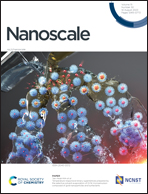An ultrasmall PVP–Fe–Cu–Ni–S nano-agent for synergistic cancer therapy through triggering ferroptosis and autophagy†
Abstract
Photothermal therapy (PTT) is an emerging field where photothermal agents could convert visible or near-infrared (NIR) radiation into heat to kill tumor cells. However, the low photothermal conversion efficiency of photothermal agents and their limited antitumor activities hinder the development of these agents into monotherapies for cancer. Herein, we have fabricated an ultrasmall polyvinylpyrrolidone (PVP)–Fe–Cu–Ni–S (PVP-NP) nano-agent via a simple hot injection method with excellent photothermal conversion efficiency (∼96%). Photothermal therapy with this nano-agent effectively inhibits tumor growth without apparent toxic side-effects. Mechanistically, our results demonstrated that, after NIR irradiation, PVP-NPs can induce ROS/singlet oxygen generation, decrease the mitochondrial membrane potential, release extracellular Fe2+, and consume glutathione, triggering autophagy and ferroptosis of cancer cells. Moreover, PVP-NPs exhibit excellent contrast enhancement according to magnetic resonance imaging (MRI) analysis. In summary, PVP-NPs have a high photothermal conversion efficiency and can be applied for MRI-guided synergistic photothermal/photodynamic/chemodynamic cancer therapy, resolving the bottleneck of existing phototherapeutic agents.



 Please wait while we load your content...
Please wait while we load your content...